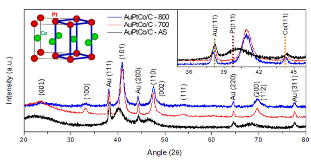Au-Doped Stable L1 0 Structured Platinum Cobalt Ordered Intermetallic Nanoparticle Catalysts for Enhanced Electrocatalysis
- Brookhaven National Lab. (BNL), Upton, NY (United States). Chemistry Dept.; Columbia Univ., New York, NY (United States). Dept. of Chemical Engineering
- Columbia Univ., New York, NY (United States). Dept. of Chemical Engineering
- Brookhaven National Lab. (BNL), Dept. of Condensed Matter Physics and Materials Science
- Brookhaven National Lab. (BNL), Upton, NY (United States). Chemistry Dept.
- Brookhaven National Lab. (BNL), Upton, NY (United States). Chemistry Dept.; Korean Inst. of Energy Research, Daejeon (South Korea). Fuel Cell Lab.
- Brookhaven National Lab. (BNL), Upton, NY (United States). Chemistry Dept.; Columbia Univ., New York , NY (United States). Dept. of Chemical Engineering
Bimetallic Pt3Co alloys are the commercial electrocatalysts for the oxygen reduction reaction in a fuel cell, but their high Pt loading and durability are a concern. Working toward the goal of reducing the amount of Pt and simultaneously increasing the activity and stability of the catalyst, we describe two new structures of ordered intermetallics consisting of Pt4Co5 nanocatalyst protected by Au atoms. Varying the temperature for the formation of the intermetallics, two distinct PtCo structural characteristics were observed in the nanoparticles: one with a simple intermetallic structure and the other with an intermetallic structure core protected by a shell of Pt atoms. Finally, the improved electrocatalytic activity and durability are attributed to the atomically ordered structure of PtCo nanoparticles along with protective surface Au atoms as confirmed by density functional theory (DFT) calculations and experimental results.
- Research Organization:
- Lawrence Berkeley National Lab. (LBNL), Berkeley, CA (United States). National Energy Research Scientific Computing Center (NERSC)
- Sponsoring Organization:
- USDOE Office of Science (SC)
- Grant/Contract Number:
- 20158520030830; SC0012704; FG02-13ER16381; AC02-05CH11231
- OSTI ID:
- 1544237
- Journal Information:
- ACS Applied Energy Materials, Vol. 1, Issue 8; ISSN 2574-0962
- Publisher:
- American Chemical Society (ACS)Copyright Statement
- Country of Publication:
- United States
- Language:
- English
Web of Science
Facile fabrication of bimetallic Cu–Ag binary hybrid nanoparticles and their application in catalysis
|
journal | January 2019 |
Similar Records
Effects of crystal phase and composition on structurally ordered Pt–Co–Ni/C ternary intermetallic electrocatalysts for the formic acid oxidation reaction
Metal-organic frameworks derived platinum-cobalt bimetallic nanoparticles in nitrogen-doped hollow porous carbon capsules as a highly active and durable catalyst for oxygen reduction reaction




